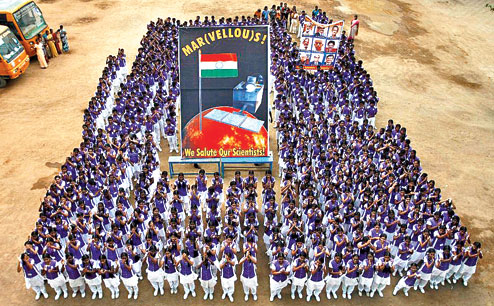 |
| Students at a Chennai school celebrate the Mars mission. (Reuters) |
New Delhi, Sept. 24: The first stirrings that culminated in India’s mission to Mars may be traced back to a decision taken about 35 years ago by the late Satish Dhawan, who was then the chairman of the Indian Space Research Organisation.
Dhawan, while walking with a fellow space scientist on an evening along the beaches of Sriharikota, India’s spaceport on the east coast, said the space agency should initiate at least a pencil-and-paper research effort on orbital mechanics.
India had then just launched its first satellite-ferrying rocket, the Satellite Launch Vehicle-3, designed to carry small satellites into low-Earth orbit. But Dhawan was thinking about the far future. “How are we ever going to undertake scientific missions beyond Earth orbit if we do not have some capability in orbital mechanics,” Dhawan asked the scientist, who recalled the conversation today hours after India placed a spacecraft into Mars orbit.
Within weeks, the space agency assigned the task to a group of scientists at the Vikram Sarabhai Space Centre, Thiruvananthapuram. Among them was Vipparthi Adimurthy, a mathematician whose orbit-designing skills played a critical role in MOM’s journey.
Senior Isro scientists say the spacecraft’s success in reaching Mars orbit this morning relied as much on hundreds of hours of theoretical calculations and computer simulations as on an array of technology innovations that a mission to Mars demanded.
One example is a set of accelerometers — devices that sense the velocity of the spacecraft — the most sensitive that Isro has ever built. The accelerometer measurements help determine when rocket engines should stop after a firing.
“The level of precision that is required for such a mission demanded extremely sensitive accelerometers — far superior in quality over the ones we’ve used in earlier space missions,” said Alur Seelin Kiran Kumar, director of the Space Applications Centre, Ahmedabad.
The MOM spacecraft is also the “smartest” built by the Isro Satellite Centre, Bangalore, armed with onboard computers for realtime decision-making — human guidance from the ground is impractical as it takes over 12 minutes for signals from Earth to reach the spacecraft when it is close to Mars. The entire orbital insertion operation this morning was performed by computers running on electronic commands loaded last week.
The mission, scientists say, was also implemented in record time — less than three years.
Isro chairman Kopillil Radhakrishnan asked Adimurthy to conduct a feasibility study only in July 2010, and the mission received approval only in 2011 — with just about two years to make it to the November 2013 launch window, when the two planets would be close enough to make a mission feasible.
While a spacecraft to Mars needed to have been launched ideally on Isro’s Geosynchronous Satellite Launch Vehicle (GSLV), the failure of a test flight of the GSLV in December 2010 meant that scientists had to rely on the smaller and less powerful proven workhorse — the Polar Satellite Launch Vehicle. But November 2013 was the closest opportunity that Isro would get to use a PSLV — the next opportunity in December 2016 would have necessarily required the more powerful GSLV because of the positions of Earth and Mars in the solar system at that time.
“Each window of launch opportunity requires a different energy level,” said Adimurthy, now a professor and dean of research at the Indian Institute of Space Science and Technology, Thiruvananthapuram, who was in the control room today.
“If we had to use the PSLV, we had to launch in November 2013,” he said. But the PSLV launch required a special outbound trajectory — one involving multiple elliptical orbits around Earth, periodic velocity increases, and then the 10-month journey to Mars.
The weight constraints imposed by the PSLV also forced Isro scientists to miniaturise the five scientific instruments on the spacecraft — innovating to make them small and light enough to be accommodated on the spacecraft yet good enough to do meaningful science.
“We had to accommodate five instruments within 15kg,” Kiran Kumar said.
The MOM spacecraft is the second from Earth to enter Mars orbit this week. The US National Aeronautics and Space Administration announced that its Mars Explorer and Volatile Evolution (Maven) spacecraft entered Mars orbit on September 22.
“It’s taken 11 years from the original concept for Maven to now having a spacecraft in orbit at Mars,” Bruce Javosky, Maven’s principal investigator at the University of Colorado, Boulder, said after learning of the spacecraft’s arrival at its destination.
In contrast, MOM’s move from a mere idea to arrival at destination took less than four years.
 |
 |
 |

